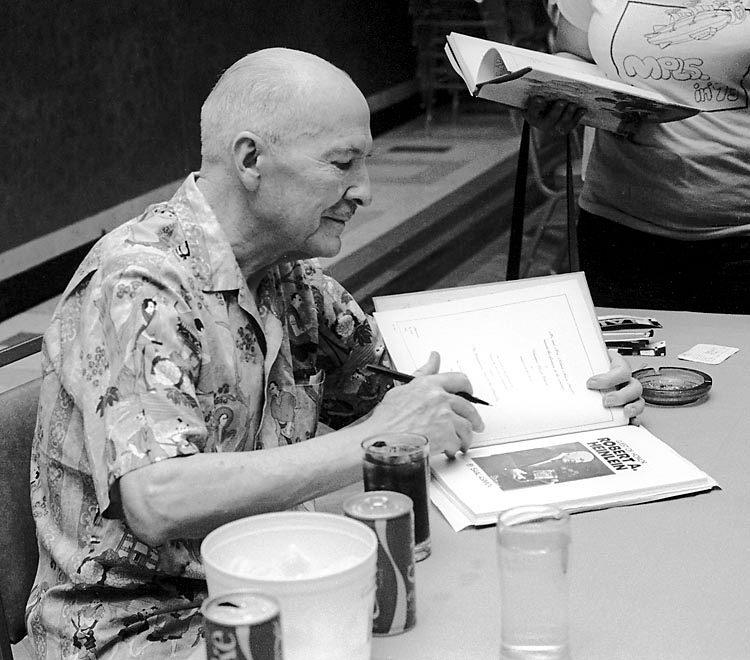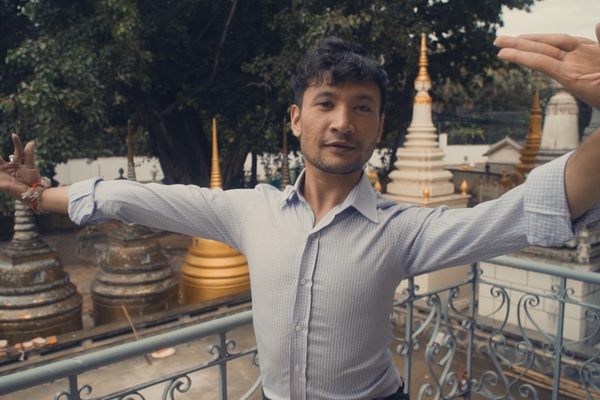Will We Ever Know Who Staged This Mysterious Moon Ballet?
A snap from the set of a 1950 sci-fi film has set off a seven-year hunt.
(Photo: llan Grant /The LIFE Picture Collection/Getty Images)
The picture above of two ballet dancers soaring across a simulated lunar crater comes from the set of Destination Moon, a 1950 space adventure film. But the dance is not in the film. The context of the photograph is unknown, and the identity of the dancers a mystery—one that William Higgins, a radiation safety physicist at Fermi National Accelerator Laboratory in Illinois, has been trying to solve since he first stumbled across the photo seven years ago.
“Finding the pictures came as a complete surprise to me and other people who are very familiar with the history of the production of Destination Moon,” says Higgins. “Even though I know a lot about the film, I never heard anybody mention ballet dancers.”
The image is one of approximately 86 mysterious LIFE magazine photographs taken by Allan Grant. The series of photos titled “Preparation ‘Moon Ballet’” shows an undocumented performance of three dancers— one man and two women—prancing, pirouetting, climbing, and flying in a fantastical lunar world created on the Eagle Lion Films Hollywood sound stages in 1949.


“It’s closer than you think!” A magazine ad of Destination Moon. [Photo: Rossano aka Bud Care/CC BY 2.0]
Destination Moon is regarded as one of the first feature films to attempt to accurately depict a trip to space. The producers brought on screenwriters, such as former engineer and science-fiction writer Robert Heinlein, consulted astronomers, and conducted background research on physics, rocketry, and astronomy. There were countless exchanges and some internal debates over discrepancies in the set design and costumes, the crew laboriously accounting for technical details while also understanding the limitations of their production budget.
“To the best of my knowledge, this is the first serious space picture that’s been made in the United States,” director Irving Pichel said in an on-set interview. “More than that it’s the first picture made about a trip to the moon in which they didn’t find pretty girls there.”
The plot is simple: a rocket carries four astronauts to the moon, where they must overcome the unexpected elements of outer space. “I think today, it’s not as solid a story as you like,” Higgins says. “But you get a whole sense of wonder from seeing a shiny rocket take off and four brave men try to keep from getting killed.”
 Destination Moon director Irving Pichel brushed up on astronomy and the laws of gravity to give a realistic movie about space.
Destination Moon director Irving Pichel brushed up on astronomy and the laws of gravity to give a realistic movie about space. Higgins has done extensive research on Destination Moon’s production. He wrote a chapter on it in a book about Heinlein, for which he acquired and examined a box full of Heinlein’s letters archived by the University of California, Santa Cruz. He’s read different descriptions of the set, watched old interview segments with the crew, and pored over a 48-minute documentary of the making of the film. But nothing hinted at what Grant was up to while photographing Destination Moon.
Around December 1949, LIFE magazine sent Grant to capture the impressive moon dreamscape. Grant took hundreds of behind-the-scenes photos of the actors, the moon set, the space ship, and the film crew, which enriched the several vivid written accounts of the production. Richard W. MacCarthy, an officer of the Pacific Rocket Society, visited the set and noted its beauty and odd amount of Earth-bound objects lying on the moon’s surface:
“To a visitor fortunate enough to see the set for the first time under the right lighting conditions may come for an instant the nightmare feeling of having made the big trip. For an instant only, because the crater floor is littered with cigarette butts and a terrestrial stepladder lurks behind a lava crag.”
Of the rolls of film Grant shot, only a handful of photos were featured in an article in the April 24, 1950 issue of LIFE. Then, in February 2009, Google digitally archived Grant’s 200-odd photos from the Destination Moon shoot. Higgins was looking through the images when he stumbled upon two peculiar photos. The set was recognizable, but the dancers in ballet attire were not. After a few weeks of digging, Higgins uncovered 86 of the Moon Ballet photos.
Higgins presented the photos to other fans and film researchers of Destination Moon, and all were just as baffled as he was. At first, he thought that the photos were of a deleted scene, a kind of dance dream sequence that must have been cut from a film that was all about depicting space accurately. Higgins noted that the dancers do not look posed and seem to be in a choreographed performance. The sound stage and set are completely lit. The male dancer is even rigged to suspended wires, and in some photos can be seen wearing the goggles and prop magnetic boots that the astronauts wear to walk in simulated weightlessness. There are even pictures of one of the dancers posed next to producer, George Pal.

Science fiction writer Robert Heinlein, deemed the “dean of science fiction writers.” [Photo: Dd-b/CC BY-SA 3.0]
Higgins evaluated whether the photos were from a cut scene with the late William Patterson, who wrote a two-volume biography on Robert Heinlein. Patterson had read every draft of Destination Moon’s script and all of Heinlein’s papers, including correspondence on the progress of the production and story suggestions, but he couldn’t recall any evidence to support the theory. “In no draft of the script is there ever a dance or a ballet, so the idea that it’s a deleted part of the movie doesn’t hold up,” says Higgins. “If [Patterson] says there’s no ballet, I believe there’s no ballet.”
Another theory is that the Moon Ballet was an independently staged, avant-garde performance. Higgins proposed on his blog that the ballet was most likely filmed using the same cameras, lighting, and crew around the time after Destination Moon wrapped in early December of 1949. There are accounts that the set was kept for a few weeks after filming, the producers continuing to bring visitors and throwing a giant Christmas party. The timeline aligns with when Grant supposedly took the photos, which are stamped January 1, 1950.
To this day, no one can confirm the story behind the bizarre Moon Ballet photos. Higgins is still trying to find the missing links. Tracking down someone who worked in the production or who can identify the dancers will help bring him closer to solving the mystery. But even if he never finds out the full story behind the Moon Ballet, he remains amazed by Grant’s photos.
“It’s just what you’d hope a ballet on the moon would be: Dancers are soaring over this fantastic landscape,” he says. “If we never learn anything about these people and what they were up to, and we never find the lost film we think they might have been shooting, those pictures all by themselves are entertaining and stir your imagination.”













Follow us on Twitter to get the latest on the world's hidden wonders.
Like us on Facebook to get the latest on the world's hidden wonders.
Follow us on Twitter Like us on Facebook